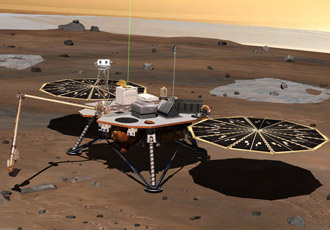The spacecraft will take off on August 3 from Cape Canaveral, and upon arrival at Mars will explore one of the coldest regions on Mars

First, the spacecraft must take off from Florida during a three-week window starting on August 3, survive the perilous entry to Mars, and land there next spring.
"Our strategy is to follow water to continue the chain of dramatic achievements from recent years about water in the history of Mars when its resemblance to Earth was greater than it is today," says Doug McQuistion, director of the Mars Exploration Program at NASA Headquarters in Washington. "Phoenix will complement our Mars research strategy by being the first spacecraft to actually touch and analyze Martian water - which is there in the form of buried ice."
"In 2002, the Mars Odyssey probe found evidence to support the theory that large parts of Mars, including the arctic plains, contain water within touching distance of the surface. "Phoenix was designed to study the history of the ice by assessing the liquid water that changed the chemistry and mineralogy of the soil," says Peter Smith, principal investigator of the Phoenix Project at the University of Arizona in Tucson.
"In addition, our instruments will be able to assess whether the polar environment is an area in which primitive bacteria can survive. To complete the scientific characterization of the area, Phoenix will monitor the polar weather and the interaction of the atmosphere with the surface. When the lander's solar collectors are deployed it will be 5.5 meters wide and 1.6 meters long. A robotic arm 2.35 meters long will dig into the ice layer, which should be only a few centimeters thick. A camera and a conductivity measuring device on the arm will study the ground and the ice there. The arm will retrieve soil samples for two instruments located inside the lander. One of them will use the heating process to test the volatile components such as water and carbon-based materials that are the essential building blocks of life. The second device will analyze the chemistry of the soil.
A meteorological station, which includes a laser to estimate the amount of water and dust in the atmosphere, will monitor the weather during the three months designated for the mission in the spring and summer of the northern hemisphere of Mars. The robot's toolkit also includes a stereoscopic camera to explore the landing site, a longer-distance camera to see the site in a wider context, and two microscopes.
For the last stage of the landing, Phoenix is equipped with deceleration systems based on pulse engines. The spacecraft will use an extremely light landing system that will allow the spacecraft to carry a heavier scientific payload. As with previous missions to Mars, Phoenix will use a heat shield to slow its speed upon entering the atmosphere, after which it will deploy a parachute adapted for supersonic speeds, to reduce the speed to 220 km/h. The lander will separate from the parachute and ignite pulses in the rocket engine, to slow down to a speed of 8 km/h before landing on its feet.
"A safe landing on Mars is difficult regardless of the method used," says Barry Goldstein, project manager for NASA's Jet Propulsion Laboratory in Pasadena, California. "Our team has been brutally testing the system since 2003 in order to identify and determine if there are any vulnerabilities."
Researchers are currently examining several potential landing sites using data from the Mars orbits to find the safest place to achieve the mission's goals. The most likely site is a wide valley with very few cliffs, in a latitude parallel to that of northern Alaska.

One response
What is a reciprocating engine?